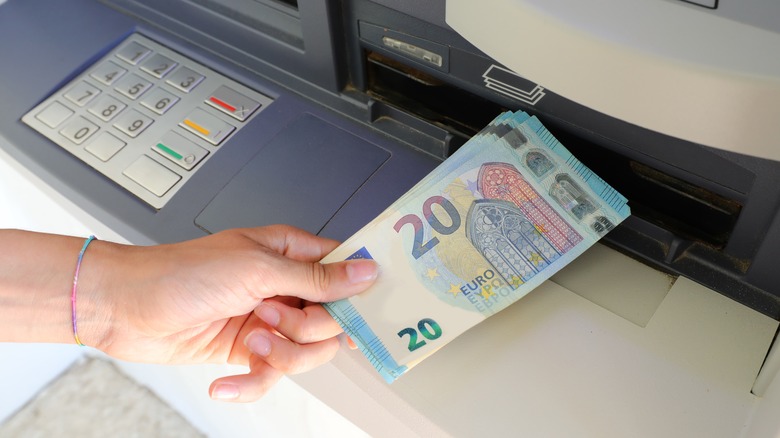The Clever Trick Rick Steves Suggests Tourists Use To Withdraw Money At An ATM In Europe
Rick Steves has been all over Europe more times than most of us have crossed the street, so when it comes to travel advice, he's practically a walking encyclopedia. Whether it's niche tips on how to enjoy solo travel without feeling like a loner or practical nuggets on picking the right luggage, he's got you covered. He also has some hard-hitting advice regarding how to protect your cash. Sure, he's an advocate of wearing money belts for your peace of mind (yes, we know they're the Crocs of travel accessories), but his expert tips are pretty foolproof. Another thing he's especially adamant about: sorting out your ATM withdrawal limits before your trip. Though ATMs are accessible nearly everywhere in Europe, many travelers still end up grumbling over denials due to a lack of funds. But it's not necessarily because they're broke.
"Remember that you're withdrawing cash in the local currency," Steves wrote on his site. "If your daily limit is $300 in US dollars, you may be able to withdraw just €275 or so (depending on the exchange rate). Many frustrated travelers get an 'insufficient funds' message and walk away from ATMs thinking their cards were rejected, when actually they were asking for more cash in euros than their daily limit allowed." So before jetting off, do yourself a favor and call your bank to bump up your daily limit. You'll thank Steves when you're not the one angrily stomping away from the ATM. And, FYI, if that doesn't work, try making multiple smaller transactions instead, as some ATMs have their own withdrawal limits.
Steves says dynamic currency conversion is rampant in Europe
Rick Steves has another travel scam to add to your radar: dynamic currency conversion (DCC). The concept sounds innocent enough — withdraw cash in your home currency rather than the local currency while traveling — but it's often a trick to squeeze a little extra cash from unsuspecting tourists. "Europe's ATMs are getting greedier and trickier. I've long advised travelers using a credit card to make purchases overseas to just say no to offers, made as if doing you a favor, 'to be charged in U.S. dollars.' This is usually just a way for the merchant's bank to impose a bad exchange rate and make a bit of extra profit off of you," Steves penned in a Facebook post.
Even bank ATMs aren't safe from this tactic. Steves said the machines are programmed with misleading prompts to get you to choose DCC, so make it a habit to be extra careful. "If an ATM offers to 'lock in' or 'guarantee' your conversion rate, choose 'continue without conversion,'" he advised, adding that you should always stick with the local currency. Otherwise, not only can you be subject to a steep exchange rate, but you may also be hit with an additional foreign transaction fee from your bank.
The DCC trap doesn't stop at ATMs. Those card machines in shops are sneaky, too. Steves suggests being extra vigilant about DCCs, no matter what the machine "helpfully" suggests, as well as avoiding debit cards as a payment method for added protection. And so, when in Europe, always remember to go with the local currency and let your dollars stay where they belong: safely in your account.

